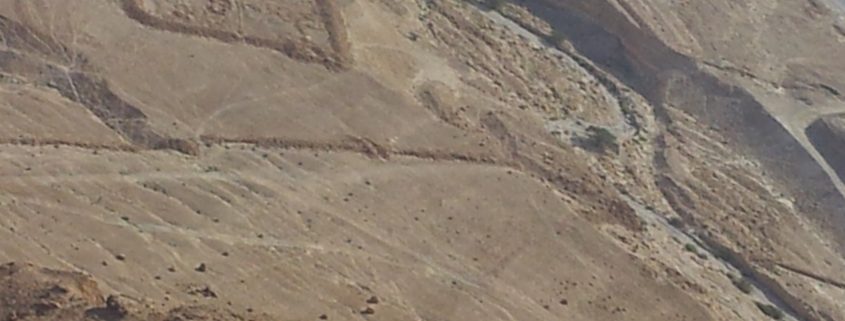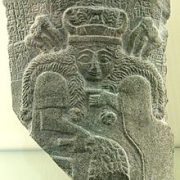Scholar Amar Annus has linked the name Sheth/Seth, found in the prophecy of Balaam
recorded in Numbers 24:17, to an infamous Amorite tribe well known in the ancient
Near East, the Suteans.
He notes that the Egyptian term for the Suteans, Šwtw, a form of the Akkadian Shutu,
appears in one of the Execration Texts from the nineteenth or eighteenth centuries B.C.,
about the time of Abraham, Isaac, and Jacob.
The Ruler of Shutu, Ayyabum, and all the retainers who are with him; the Ruler
of Shutu, Kushar, and all the retainers who are with him; the Ruler of Shutu,
Zabulanu, and all the retainers who are with him. 1

The Execration Texts were like ancient Egyptian voodoo dolls. The names of enemies
were inscribed on pottery, which were ritually cursed and then smashed. In a nutshell,
“Sheth,” “Shutu,” and “Sutean” are the same name processed through different
languages and types of writing. 2 Other Egyptian texts place the Shutu/Sheth in the
central and northern Transjordan, which, significantly, includes Bashan—Rephaim
territory. 3
Other fascinating tidbits from the Execration Texts: The Shutu leaders were listed just
after the “Rulers of Iy-‘anaq”—the Anakim tribes that Joshua and the Israelites would
fight for control of Canaan about four hundred years later. Also, the Shutu leader named
Ayyabum bears the same name as the biblical Job. Now, this was probably not the Job
of the Old Testament, but the Egyptian curse does locate him in the Transjordan, the
same general area that was home to the long-suffering Job 4 and exactly where the Bible
places the Rephaim tribes. And because you’ve read your Old Testament, you’ve
noticed that the other Shutu leader, Zabulanu, has a name that Jacob would later give
to one of his sons, Zebulon.
Here’s the key link: Annus points to an Akkadian lexical list (that’s like an ancient clay
tablet version of Google Translate) that specifically equates ti-id-nu and su-tu-u—Tidanu
and Sutean. 5 Citing Michael Heltzer’s 1981 book The Suteans, Annus continues:
In Ugaritic literature Suteans are mentioned in the epic of Aqhatu, where the
antagonist of the mt rpi Dnil [“man of the Rephaim, Daniel”] is a nomadic Ytpn,
mhr št—“warrior of the Sutû, Sutean warrior.” …In the epic of Keret Suteans are
mentioned as dtn, spelled also as ddn, and it “must be understood as the
Di/Tidânu tribe, a part of common Amorite stock. It is even likely that this term
was used in Mesopotamia at the end of the 3rd millennium to designate tribes
later known as Suteans.” 6
Highlight that! The Ugaritic Epic of Keret links the Amorite Sutean tribe, the Egyptian
Shutu and the biblical sons of Sheth, with the Ditanu—the Titans!
Here’s one more bit of historical evidence for your consideration: The Shutu are also
identified in later Egyptian texts as the Shasu, 7 probably as language and pronunciation
changed over the centuries. About two hundred years after the Exodus, Ramesses II
(“the Great”) fought an epic battle against the Hittites at Qadesh, a city on the Orontes
River near the modern border between Syria and Lebanon. According to the Egyptian
2 Ibid.
3 Amar Annus, “Are There Greek Rephaim? On the Etymology of Greek Meropes and Titanes.”
Ugarit-Forschungen 31 (1999), p. 18.
4 Most Bible commentaries place the land of Uz in the Transjordan, usually near Edom.
5 Annus, op. cit.
6 Michael Heltzer & Shoshana Arbeli-Raveh, The Suteans (Naples: Istituto Universitario
Orientale, 1981). Cited in Annus, op. cit., p. 19.
7 “Biblical Archaeology: Evidence of the Exodus from Egypt.” Institute for Biblical and Scientific
Studies. https://www.bibleandscience.com/archaeology/exodus.htm, retrieved 3/3/18.

Derek Gilbert Bio
Derek P. Gilbert hosts SkyWatchTV, a Christian television program that airs on several national networks, the long-running interview podcast A View from the Bunker, and co-hosts SciFriday, a weekly television program that analyzes science news with his wife, author Sharon K. Gilbert.
Before joining SkyWatchTV in 2015, his secular broadcasting career spanned more than 25 years with stops at radio stations in Philadelphia, Saint Louis, Little Rock, and suburban Chicago.
Derek is a Christian, a husband and a father. He’s been a regular speaker at Bible prophecy conferences in recent years. Derek’s most recent book is The Great Inception: Satan’s PSYOPs from Eden to Armageddon. He has also published the novels The God Conspiracy and Iron Dragons, and he’s a contributing author to the nonfiction anthologies God’s Ghostbusters, Blood on the Altar, I Predict: What 12 Global Experts Believe You Will See by 2025, and When Once We Were a Nation.













Sutu, Seti, Shasu ,Sassas, Shasass or Rak-Shasas were Brahmins clan. Rakshasas the Giants or Anaks. Shashas or SHASU-SUTU or KENITES or Gypsies. Sassas= Sassanid dynasty.
Hyksos SHASU with help of Hurrians – Hitties (Kurds)
Sassanid dynasty Persian royalty with help with Horrites or Hurrians Hitties (Kurds).
Rak-Shasas, Asuras, Yak-Shasas, Dayitas (Titans) migrated from India when they lost Battle with Deva Brahmins, they came to Cannan, Moab, Edom and Arabic penisula (Midian, Kedar). Also Amurru was their Kingdom. SHASU SAMATH (Hamath) Rechabites followers of Melchizedek were Shasu or Kenites ANCERSTORS OF ROMA GYPSIES. RAK-SHASAS WERE BRAHMINS Aryans mixed with Dravidians with Haplogroup H1a-M82 which is present in Roma Gypsies comunity. Rak-Shasas language was Pasiachi Prakrit which ancestors of language of Roma GYPSIES.
KAINAN:
By: Emil G. Hirsch, Kaufmann Kohler
Son of Arphaxad and father of Salah; mentioned only in Gen. xi. 13 (LXX.), Book of Jubilees, viii. 1-4, and Luke iii. 36; omitted in all other versions of Gen. xi. 13, Salah being given as the son of Arphaxad. According to the Book of Jubilees (l.c.), Kainan, taught the art of writing by his father, found carved on the rocks by former generations an inscription preserving the science of astrology as taught by the rebel angels, the Watchers, who descended from heaven in the days of Jered and led mankind away from God. Similarly, Josephus (“Ant.” i. 2, § 3) speaks of pillars of brick and stone upon which the children of Seth had inscribed their astrological knowledge for future generations. The “Sefer ha-Yashar” describes Kainan, the possessor of great astrological wisdom, which had been inscribed on tables of stone, as the son of Seth and not of Arphaxad.
Bibliography:
Charles, The Book of Jubilees, pp. 66-67, London, 1902.
Kainain his descendants son of Seth .
Brahma = Kainain?
Brahmins were Semitic people?
SEMITIC PEOLPE are Aryans ?